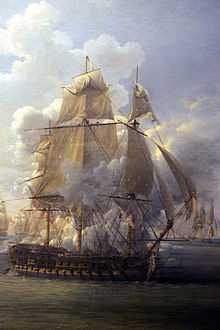HMS Hercule (1798)
 Fight of the Poursuivante - 28th of June 1803, by Louis-Philippe Crépin (detail) HMS Hercule receives raking fire | |
| Career (France) | |
|---|---|
| Name: | Hercule |
| Namesake: | Hercules |
| Ordered: | 14 August 1793 |
| Builder: | Lorient shipyard |
| Laid down: | June 1794 |
| Launched: | 5 December 1797 |
| Completed: | March 1798 |
| Captured: | 21 April 1798 |
| Career (UK) | |
| Name: | HMS Hercule |
| Acquired: | 21 April 1798 |
| Fate: | Broken up in December 1810 |
| General characteristics [1] | |
| Class and type: | Téméraire-class ship of the line |
| Tonnage: | 1876 bm[2] |
| Displacement: | 2,966 tonnes 5,260 tonnes fully loaded |
| Length: | 55.87 metres (183.3 ft) (172 pied) |
| Beam: | 14.90 metres (48 ft 11 in) |
| Draught: | 7.26 metres (23.8 ft) (22 pied) |
| Propulsion: | Up to 2,485 m2 (26,750 sq ft) of sails |
| Armament: | 74 guns:
|
| Armour: | Timber |
HMS Hercule was a 74-gun third rate ship of the line of the Royal Navy. She was previously Hercule, a Téméraire class ship of the line of the French Navy, but was captured on her maiden voyage in 1798, and spent the rest of her career as a British ship. She was broken up in 1810.
French career and capture

During her maiden journey, on 21 April 1798, and just 24 hours out of port, she was captured by the British ship HMS Mars after a violent fight at the Battle of the Raz de Sein, off Île de Sein near Brest. Hercule attempted to escape through the Passage du Raz, but the tide was running in the wrong direction, and she was forced to anchor, giving the British the chance to attack at close quarters. The two ships were of equal force, both seventy-fours, but Hercule was newly commissioned; after more than an hour and a half of bloody fighting at close quarters she struck her colours at 10.30 pm, having lost — by her own officers' estimate — 290 men killed and wounded. On Mars 31 men were killed, including her captain, Alexander Hood, and 60 wounded. Captain Louis Lhéritier of Hercule was wounded by sabre and spike leading his boarding party.[3]
The Hercule was recommissioned in the Royal Navy as HMS Hercule.
British career
In mid-1803, the squadron under Captain Henry William Bayntun, consisting of Cumberland, Hercule, Bellerophon, Elephant, and Vanguard captured Poisson Volant and Superieure.[4] The Royal Navy took both into service.
On 28 June 1803, during the Blockade of Saint-Domingue, HMS Hercule encountered the French frigate Poursuivante and the corvette Mignonne. Hercule attempted to capture the Poursuivante, but the frigate outmaneuvered her and she received raking fire. The incident was immortalised in a painting by Louis-Philippe Crépin. HMS Goliath then captured Mignonne.
See also
Citations
- ↑ Clouet, Alain (2007). "La marine de Napoléon III : classe Téméraire - caractéristiques". dossiersmarine.free.fr (in French). Retrieved 4 April 2013.
- ↑ Colledge, J. J.; Warlow, Ben (2006) [1969]. Ships of the Royal Navy: The Complete Record of all Fighting Ships of the Royal Navy (Rev. ed.). London: Chatham Publishing. ISBN 978-1-86176-281-8. OCLC 67375475. P. 161
- ↑ Quintin, Danielle et Bernard (2003). Dictionnaire des capitaines de Vaisseau de Napoléon. S.P.M. pp. 242–243. ISBN 2-901952-42-9.
- ↑ The London Gazette: no. 15620. p. 1228. 13 September 1803.
References
- Winfield, Rif (2007). British Warships in the Age of Sail 1793–1817: Design, Construction, Careers and Fates. Seaforth. ISBN 1-86176-246-1.
External links
- Benyon, P. (2011). "HMS Hercule". Index of 19th Century Naval Vessels.